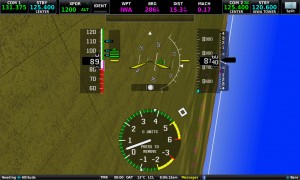This cockpit video at the bottom of the page illustrates the value of on-aircraft UPRT. The illustrated scenario cannot be effectively practiced in today’s advanced full flight simulators, which are not programmed for the aerodynamic conditions of a full aerodynamic stall with substantial sideslip present. These are the conditions which could be faced if a stall in a multi-engine aircraft was encountered with one engine inoperative. The use of the SIAI Marchetti S211 training aircraft allows pilots to see the actual results of cross-controlled stalls and practice proper recovery techniques in a safe but realistic environment.
 There are several important training points to note in the video below:
There are several important training points to note in the video below:
- Today’s most advanced simulators, even extended envelope simulators, are quite limited in the amount of flight test data associated with full stalls with substantial sideslip present. At best, the airplane performance presented in a substantially uncoordinated full aerodynamic stall presented by advanced simulators are a ‘best guess’ based on wind tunnel and extrapolated data, if that data is even included into the aero model of the simulator.
- Even though the airplane has a modern Garmin AOA probe and glass cockpit presentation of the AOA value, due to the uncoordinated entry, there is little to no pre-stall warning. Interestingly, the exact same skidded stall maneuver done in a right turn gives plenty of pre-stall warning. This does not mean that Garmin doesn’t make good AOA products, they do. However, APS has found this unreliability to be true of all the civilian AOA systems we have tested related to stalled flight conditions. If pilots believe an AOA indicator is the silver bullet concerning stall prevention and recovery, they are mistaken even if they know exactly how to read the instrument and have been trained on how to interpret it.
- The primary purpose of the Skidded Turn Stall is to emphasize Upset Awareness and Upset Prevention. Although the altitude indication in this video lags (altitude and airspeed are not connected via Bluetooth to the APS Garmin VIRB XE recorder like attitude is), it can be clearly seen that that aircraft is using approximately 800′ of altitude to recover from the situation even using an ideal recovery technique. An important message to pilots is that should the aircraft actually get to an aerodynamic stall in the Skidded Turn during a circle to land or in the latter base/final legs of the traffic pattern, there simply may not be enough altitude or time available to survive. This is an important point. Even an ideally trained pilot on stall recovery flying a circle to land approach at a circling altitude of 600′ agl in the scenario below could not survive the encounter. This is a very powerful example of why it’s important for fully comprehensive UPRT solutions to focus on Upset Awareness and Upset Prevention. Learn more in our dedicated Online Course titled ‘THE FATAL NATURE OF CROSS-CONTROL STALLS‘
- Reality Check: Let’s not get the wrong message. Upset RECOVERY is an essential part of stall training as the pilot must see the fully evolved aerodynamic stall event to gain an ingrained understanding of stall prevention. Proper stall training must include the escalation of the flight condition from slow flight, to approach to stall, to stall (coordinated and uncoordinated) followed by repetitive preventive and recovery intervention training at each phase of the escalation.
- Why didn’t the pilot pull more G during the recovery? Good question, but it’s also one of the reasons why 50% of fatal loss of control accidents are due to the stall. The pilot in this scenario can not pull more G during the recovery (Stabilize phase) due to airspeed available post-stall. Altitude loss can be minimized in a dive recovery post-stall by:
- ensuring the wings are level
- loading the airplane to a maximum AOA (the maximum lift available) that falls short of the Critical AOA
- managing energy state by accelerating post-stall while maximizing lift yet keeping airspeed below Va throughout the dive portion of the recovery.
- Post-event discipline: Pilots of complex aircraft must ensure the aircraft is stabilized in pitch, power, configuration, and trim after any airplane upset before taking their mind off of the primary task of safe and effective recovery. Then and only then can they safely begin to expand their situational awareness to tasks such as troubling and longer-term strategies to get the airplane back on the ground safely.




Comments: